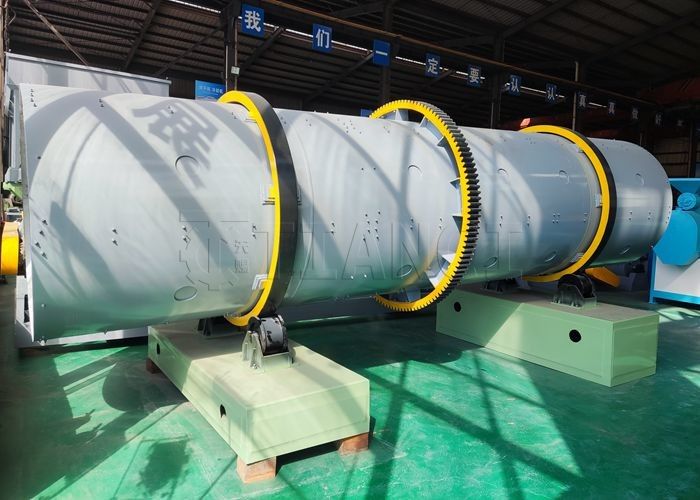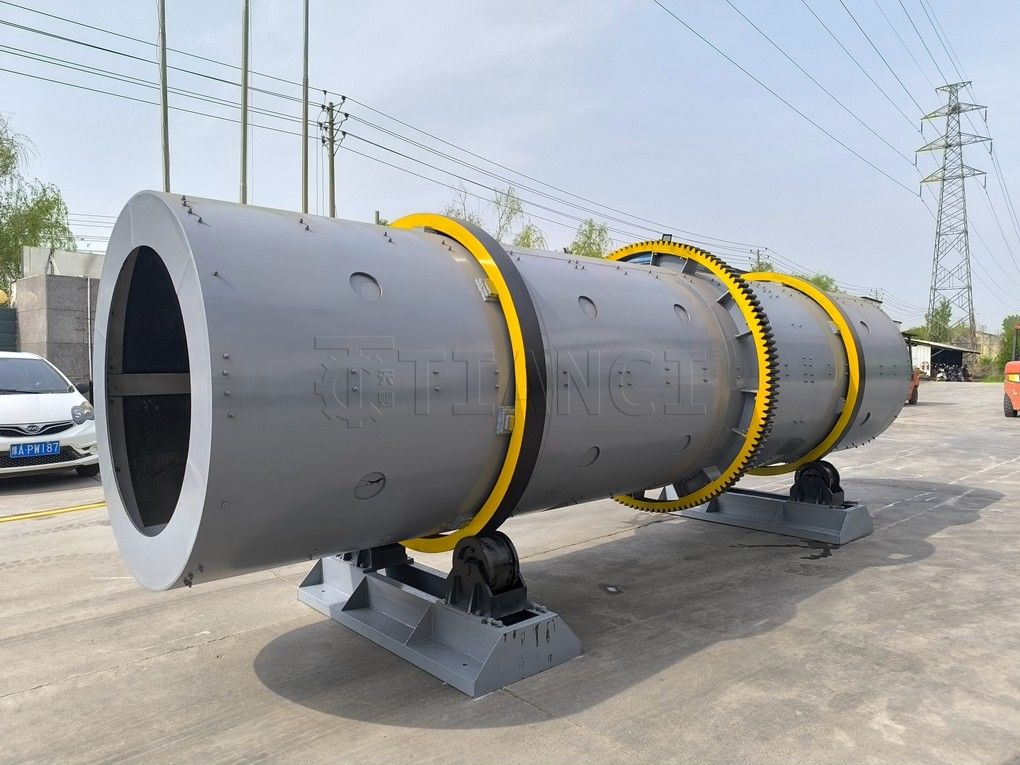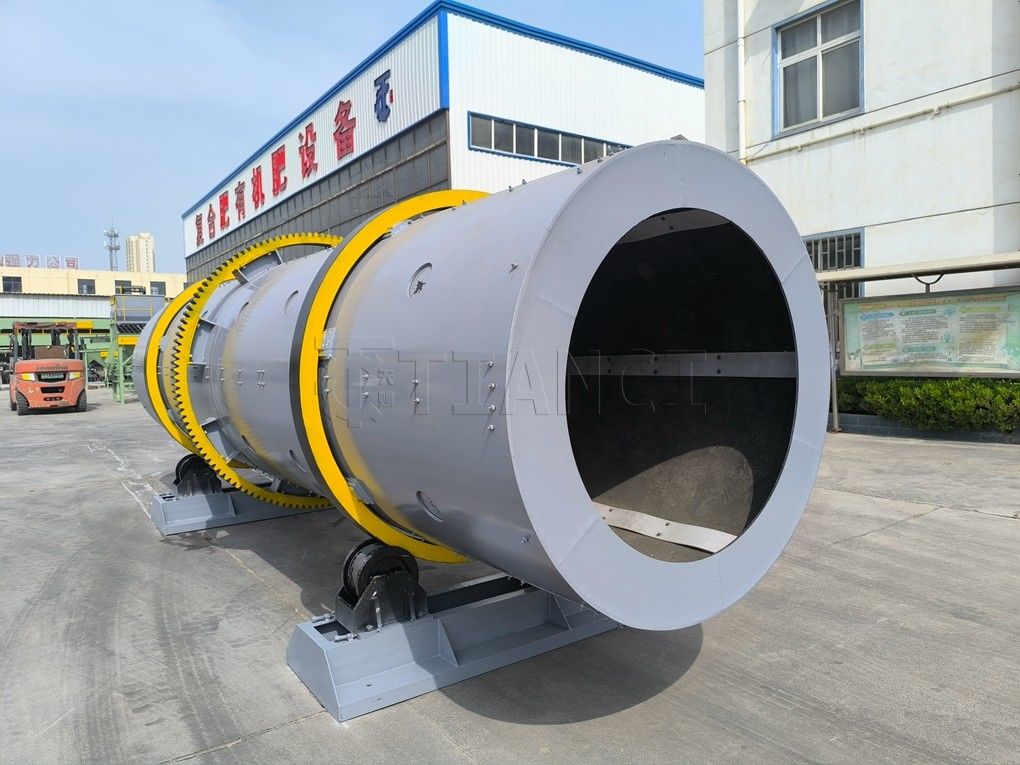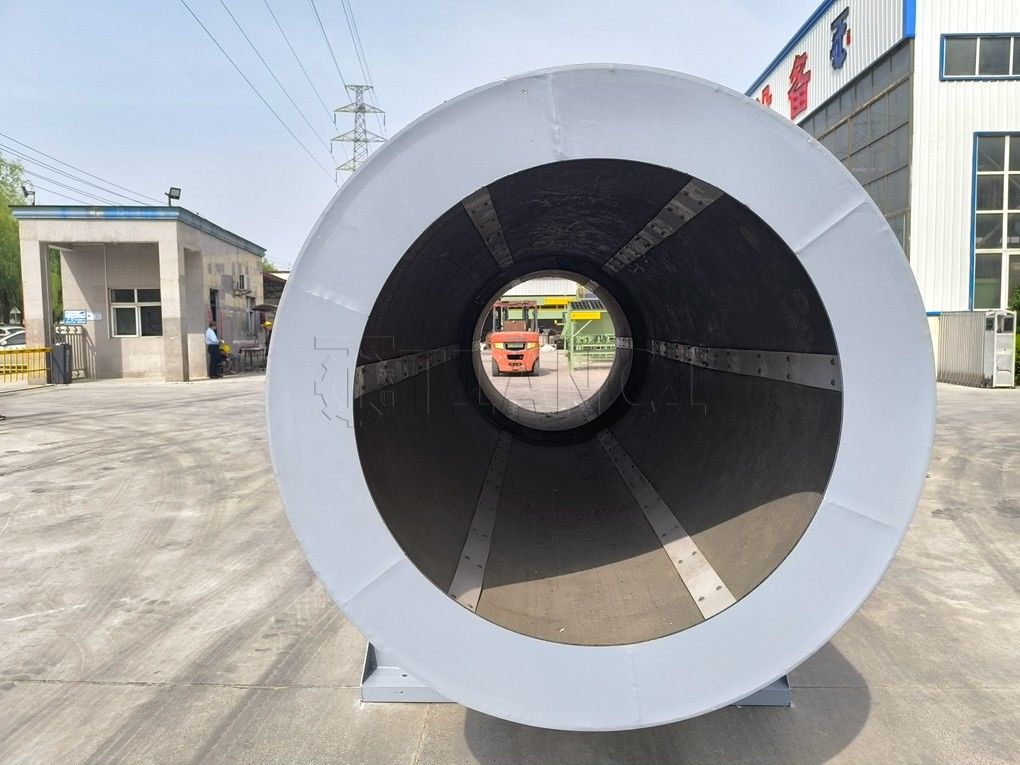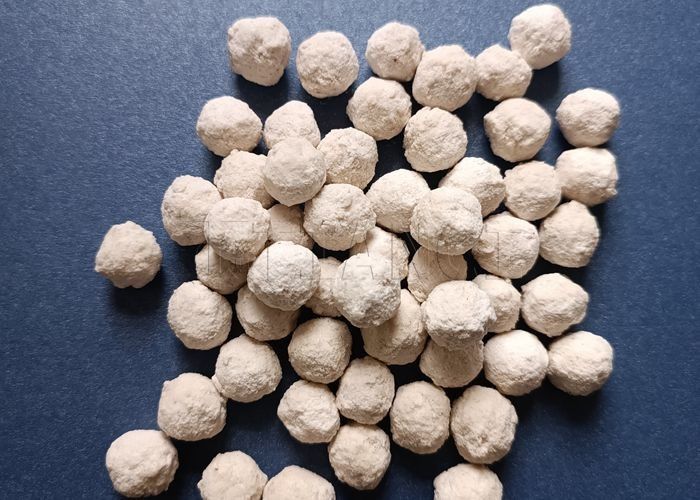Introduction of rotary drum granulator for fertilizer
The rotary drum granulator is a widely used granulation equipment in the fertilizer, feed, mining, and other industries. It primarily forms powdered materials into granules through rotational motion. Its core components include an inclined rotating cylinder, a feeding device, a transmission system, and a discharge port.
During operation, powdered material enters the cylinder via the feeding device. As the cylinder rotates, the material gradually forms granules through rolling, friction, and the action of an external binder. Driven by gravity and centrifugal force, the formed granules move along the cylinder wall toward the discharge port and are discharged.
The rotary drum granulator offers several advantages, such as high granulation efficiency, a high granulation rate, low energy consumption, simple operation, and convenient maintenance, making it suitable for the granulation needs of various materials. To achieve optimal granulation results, parameters including the drum’s rotational speed, inclination angle, and cylinder lining can be adjusted according to different process requirements.

Parameter
|
Model
|
Inner diameter
(m)
|
Inclination
(° )
|
Rotation speed
( r/min )
|
Power
( kw)
|
Capacity
( t/h )
|
|
ZG1240
|
1.2
|
2-5
|
4.7
|
5.5
|
1-3
|
|
ZG1450
|
1.4
|
2-5
|
5
|
7.5
|
3-4
|
|
ZG1560
|
1.5
|
2-5
|
5
|
11
|
5-8
|
|
ZG1870
|
1.8
|
2-5
|
3.9
|
15
|
8-10
|
|
ZG2080
|
2
|
2-5
|
3.9
|
18.5
|
10-15
|
|
ZG2290
|
2.2
|
2-5
|
3.2
|
22
|
15-20
|
|
ZG24100
|
2.4
|
2-5
|
3
|
30
|
20-25
|
The key structural components of the rotary drum granulator include:
An inclined rotating cylinder: The core working part, whose inclination angle and rotational speed directly affect granulation efficiency and product quality.
A feeding device: Ensures uniform and stable delivery of powdered materials into the cylinder, preventing material accumulation or uneven distribution.Powers the rotation of the cylinder, typically consisting of a motor, reducer, and driving pulley, which enables adjustable rotational speed.
A discharge port: Located at the lower end of the inclined cylinder, it facilitates the smooth collection of finished granules.
Granulation Requirements for Drum Granulator
During the drum granulation process, in addition to the main raw materials such as nitrogen, phosphorus, potassium, and organic fertilizers, various trace elements and auxiliary materials can also be added.
① To ensure the strength of the granulated particles, binders such as humic acid, lignin, or bentonite can be added during the granulation process, depending on the raw materials. It is essential to ensure thorough mixing of the binders with the raw materials. Additionally, when granulating organic fertilizer raw materials, an appropriate amount of urea or straw powder can be added to adjust the material's viscosity—whether it is insufficient or excessive—thereby enhancing the pelletizing effect.
② Ensure that the granulator is set at an appropriate installation angle (generally a 2-5° inclination) based on the characteristics of the material to achieve the best granulation results.
Applications:
1.Flexible Fertilizer Production – Efficiently manufactures NPK, NP, NK, and other multi-nutrient fertilizers.
2.Dry Granulation – Converts fine chemical powders into dense, long-lasting granules without water.
3.Optimized for Agriculture – Delivers uniform granules and consistent nutrient content for large-scale farming.
4.Custom Formulations – Allows tailored fertilizer blends to suit specific soil conditions and crop requirements.

ADVANCES IN GRANULATION DRUM DESIGN
Nearly all industries have seen tremendous advancements due to modern technology. Some of the key advancements in granulation drum design include: Flexible and Corrosion-Resistant Drum Liners: Liners can be used to reduce or eliminate material build-up on the drum walls, as well as decrease the potential for damage caused by corrosive materials. Tumbler flights: Tumbling flights can be used to increase the material agitation in order to perfect the cascading effect and create the desired granule properties.
CONCLUSION
The granulation drum has long served as the basis of modern fertilizer production. This versatile piece of equipment has helped bring numerous fertilizer products to the consumer market by creating a durable granule that is easy to handle, package, ship, and apply. TIANCI has been the preferred supplier of granulation drums to the fertilizer industry for over 10 years. Our granulation drums are rugged, reliable, and manufactured to the highest quality standards. We also offer unparalleled feasibility testing and granulation process development services in our testing facilities, as well as comprehensive parts and service support. To learn more about our granulation drums or services, contact us today!
Rotary Drum Granulator Frequently Asked Questions (FAQs)
Q: Could you please specify the hourly output range of your drum granulator?
A: The standard hourly output of our drum granulator ranges from 1 to 300 tons. If you have higher output demands (e.g., over 25 tons per hour), we can tailor a customized solution based on your specific production needs.
Q: HOW DOES A ROTARY DRUM GRANULATOR WORK?
A: A drum granulator works by tumbling material in the presence of a liquid binder to encourage granule formation and growth. Feed material and binder are constantly fed through the rotating drum. The rolling action, combined with the stickiness from the binder, causes fines to collect together into particles. These particles continue to pick up additional fines and binder as they tumble in the bed, causing them to densify and pick up additional layers in a phenomenon known as coalescence. Tumbling flights can be incorporated into the unit to increase agitation of the material bed.
This way of forming agglomerates is a type of agitation agglomeration also known as wet granulation, balling, or pelletizing.
Q: WHAT TYPES OF MATERIALS CAN A ROTARY DRUM GRANULATOR PROCESS?
A: Generally speaking, drum granulators can process any bulk solid in the form of a dry, fine powder. This flexibility lends well to a host of industries, processing materials ranging from specialty chemicals and fertilizers, to minerals and ores, and everything in between.
In some cases, the feedstock may require pretreatment in the form of crushing, grinding, or drying to be a suitable feed for the granulator and produce the characteristics desired in the end product.
Q: WHAT’S THE ADVANTAGE OF A ROTARY DRUM GRANULATOR OVER A DISC PELLETIZER?
A: In choosing between a drum granulator and a disc pelletizer, the drum is often chosen because it offers a higher throughput than the disc pelletizer. The rotary drum also has the advantage of being a “closed” system, meaning that granulation occurs inside a contained environment, so fugitive material is limited.
WHAT CAPACITIES CAN A GRANULATION DRUM ACCOMMODATE?
A: Granulation drums can be customized to nearly any size, accommodating capacities ranging from 500 lb/hr – 3500 TPH+.
ARE DRUM GRANULATORS BATCH OR CONTINUOUS?
A: Rotary drum granulators are typically employed in a continuous setting, though they may function as a batch device in some R&D environments, such as the TIANCI Innovation Center.
Q: WHAT IS THE RETENTION TIME OF A ROTARY DRUM GRANULATOR?
A: Retention time is one process parameter used to control the characteristics and quality of the material exiting the drum, so it can vary significantly depending on the process and product goals. In general, retention time in a granulator may fall anywhere between 30 seconds and 60 minutes.
Q: WHAT ARE THE TYPICAL WEAR ITEMS?
A: Rotary drum granulators are generally low maintenance, but some items can become worn, depending on the operating conditions, and particularly if the drum falls out of alignment. The most common wear items for a drum granulator typically include the liner (where applicable), tumbling flights (where applicable), and potentially trunnion wheels, tires, and thrust rollers.
Rotary drum alignment is an important aspect of drum maintenance to prevent wear of the tires and trunnion wheels. When a drum falls out of alignment, it puts added stress on all components, encouraging undue wear.
Q: DOES THE PRODUCT EXITING THE GRANULATOR REQUIRE DRYING?
A: Since the granulation process relies on a liquid binder to form and layer granules, the product exiting the granulator is wet and must be dried unless it is moving immediately to a downstream process that does not require drying (such as in the case of iron ore balling, where pellets go to a grate kiln).
Drying is typically carried out in a rotary dryer, which further rounds and “polishes” the granules as a result of the tumbling action that occurs as the drum rotates.
Q: HOW DO I KNOW IF A ROTARY DRUM GRANULATOR IS RIGHT FOR MY APPLICATION?
A: Whether or not a rotary drum granulator is the right fit for a given project depends on specific process and product goals, such as capacity, level of control over particle characteristics, product parameters, and more.
When it is not clear if a drum granulator will be able to meet the project objectives, testing can be carried out in the TIANCI Innovation Center to evaluate the process and identify the most suitable equipment configuration.
Q: IS ANY OTHER EQUIPMENT REQUIRED TO SUPPORT A ROTARY DRUM GRANULATOR?
A: Drum granulators require a feeding and offtake system to convey material into and away from the drum. They also typically require screens and a recycle circuit to recover overs and unders and recycle them back into the process
Drum granulators are also typically followed by a rotary dryer and in some cases, may be preceded by a mixer for providing a homogeneous feedstock to the unit.
Q: WHAT DOES THE DESIGN PROCESS LOOK LIKE?
A: Rotary drum granulator design typically begins with testing to assess the feasibility of granulating the intended material and to gather key process data such as percent fill, retention time, drum speed and slope, spray system design, and more.
Once the data has been gathered, engineers work off of this to size the drum and incorporate any necessary features or modifications needed to produce the desired product at the intended capacity.
Q: WHAT DATA IS NEEDED TO DESIGN A ROTARY DRUM GRANULATOR?
A: A variety of data points are necessary to design the granulator. Along with a process description, the follow data is typically required:
Why Choose Us?

Support and Services:
We are committed to providing our customers with comprehensive support and reliable services. Our company offers free process design drawings tailored to your needs, as well as free trial testing services to ensure optimal machine performance. Every machine comes with a one-year warranty for worry-free operation. In addition, we provide free installation and professional training services, helping your team quickly master the equipment and achieve efficient production.



 Ваше сообщение должно содержать от 20 до 3000 символов!
Ваше сообщение должно содержать от 20 до 3000 символов! Пожалуйста, проверьте свою электронную почту!
Пожалуйста, проверьте свою электронную почту!  Ваше сообщение должно содержать от 20 до 3000 символов!
Ваше сообщение должно содержать от 20 до 3000 символов! Пожалуйста, проверьте свою электронную почту!
Пожалуйста, проверьте свою электронную почту! 
